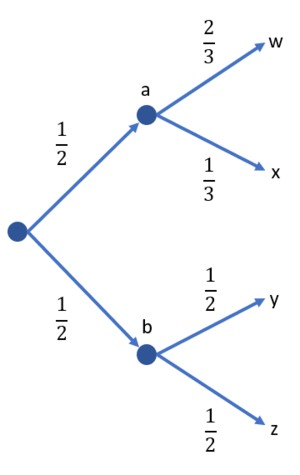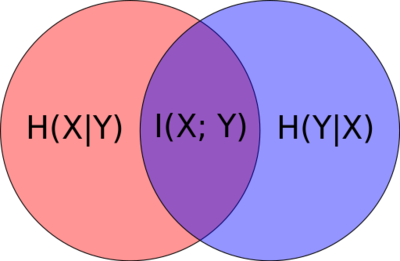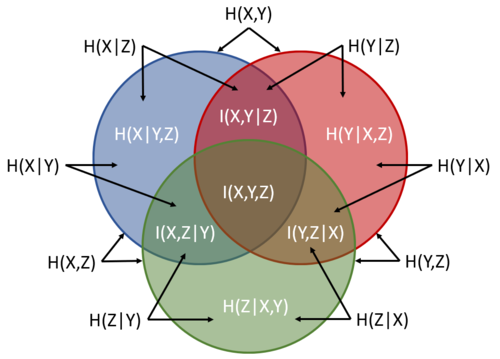Joint Entropies
In this module, we'll discuss several extensions of entropy. Let's begin with joint entropy. Suppose we have a random variable  with elements
with elements  and random variable
and random variable  with elements
with elements  . We define the joint entropy of
. We define the joint entropy of  and
and  as:
as:
-
 |
|
(1)
|
Take note that  . This is trivial. From our previous discussion about the decision trees of a game, we used joint entropies to calculate the overall entropy.
. This is trivial. From our previous discussion about the decision trees of a game, we used joint entropies to calculate the overall entropy.
Conditional Entropies
There are two steps to understand conditional entropies. The first is the uncertainty of a random variable caused by a single outcome only. Suppose we have the same random variables  and
and  defined earlier in joint entropies. Let's denote
defined earlier in joint entropies. Let's denote  as the conditional probability of
as the conditional probability of  when event
when event  happened. We define the entropy
happened. We define the entropy  as the entropy of the random variable
as the entropy of the random variable  given a
given a  happened. In other words, this is the average information of all the outcomes of
happened. In other words, this is the average information of all the outcomes of  when event
when event  happens. Take note that we're only interested in the entropy of
happens. Take note that we're only interested in the entropy of  when only the outcome
when only the outcome  occurred. Mathematically this is:
occurred. Mathematically this is:
-
 |
|
(2)
|
Just to repeat because it may be confusing, equation 2 just pertains to the uncertainty when only a single event happened. We can extend this to the total entropy  when any of the outcomes in
when any of the outcomes in  happens. If we treat
happens. If we treat  like a random variable that contains a range of
like a random variable that contains a range of  and the probability distribution for each associated
and the probability distribution for each associated  is
is  so that
so that  is a function of
is a function of  . Then we define
. Then we define  as the conditional probability of
as the conditional probability of  given
given  as:
as:
-
 |
|
(3)
|
Substituting equation 2 to equation 3 and knowing that  . We can re-write this as:
. We can re-write this as:
-
 |
|
(3)
|
Note that it is trivial to prove that  if
if  and
and  are independent. We'll leave it up to you to prove this. A few hints include:
are independent. We'll leave it up to you to prove this. A few hints include:  and
and  if
if  and
and  are independent.
are independent.
Binary Tree Example

Figure 1: Binary tree example.
Let's apply the first two concepts in a simple binary tree example. Suppose we let  be a random variable with outcomes
be a random variable with outcomes  and probabilities
and probabilities  . Let
. Let  be the random variable with outcomes
be the random variable with outcomes  . We are also given the probabilities
. We are also given the probabilities  ,
,  ,
,  , and
, and  . Figure 1 shows the binary tree. Calculate:
. Figure 1 shows the binary tree. Calculate:
(a) 
(b) 
(c) 
(d) 
Solution
(a) Use equation 2 to solve 

(b) Same as in (a), use equation 2 to solve 

(c) Can be solved in two ways. First is to use equation 3.

Or, we can solve it using the alternative version of equation 3. But we also need to know the joint probabilities:





(d) We already listed the joint probabilities in (c). We simply use equation 1 for this:

Important Note!
This example actually shows us an important observation:
-
 |
|
(4)
|
We can easily observe that this holds true for the binary tree example. This has an important interpretation: The combined uncertainty in  and
and  (i.e.,
(i.e.,  ) is the sum of that uncertainty which is totally due to
) is the sum of that uncertainty which is totally due to  (i.e.,
(i.e.,  ), and that which is still due to
), and that which is still due to  once
once  has been accounted for (i.e.,
has been accounted for (i.e.,  ).
).
Since  it also follows that:
it also follows that:
-
 |
|
(5)
|
If  and
and  are independent then:
are independent then:
-
 |
|
(6)
|
An alternative interpretation to  is the information content of
is the information content of  which is NOT contained in
which is NOT contained in  .
.
Mutual Information
With the final discussion on the properties of joint and conditional entropies, we also define mutual information as the information content of  contained within
contained within  written as:
written as:
-
 |
|
(7)
|
Or:
-
 |
|
(7)
|
If we plug in the definitions of entropy and conditional entropy, mutual information in expanded form is:
-
 |
|
(8)
|
It also follows that:
 . This is trivial from equation 7.
. This is trivial from equation 7.- If
 and
and  are independent, then
are independent, then  . This is also trivial from equation 8.
. This is also trivial from equation 8.
As a short example, we can use the binary tree problem again. Let's compute  . We simply need to use equation 7:
. We simply need to use equation 7:  . We already know
. We already know  bits.
bits.  is computed by first knowing
is computed by first knowing  . Recall that:
. Recall that:

But then, for each outcome in  has the same probability of the joint entropy. For example, event
has the same probability of the joint entropy. For example, event  only occurs if event
only occurs if event  occurred first. Event
occurred first. Event  occurs only if event
occurs only if event  occurred first. So it means that:
occurred first. So it means that:




Therefore,  bits. Therefore, the information
bits. Therefore, the information  bits.
bits.
Chain Rule for Conditional Entropy
What happens when we deal with more than two random variables? To facilitate the discussion, let us recall the chain rule for joint distributions.
Let  be a sequence of discrete random variables. Then, their joint distribution can be factored as follows
be a sequence of discrete random variables. Then, their joint distribution can be factored as follows
 ,
,
Chain rule for entropy
The chain rule for (joint) entropy is very similar to the above expansion, but we use additions instead of multiplications.
-
 |
|
(9)
|
Although we do not supply a complete proof here, this fact should not be too surprising since entropy operates on logarithms of probabilities and logarithms of product terms expand to sums of logarithms.
Proof of chain rule for 
Let us see that the statement is true for  . Let
. Let  be three discrete random variables. The idea with the proof is that we operate on two random variables at a time, since prior to the chain rule we only know that
be three discrete random variables. The idea with the proof is that we operate on two random variables at a time, since prior to the chain rule we only know that  . We can write
. We can write  , where we bundle
, where we bundle  and
and  into one random variable
into one random variable  .
.
The proof now proceeds as follows:
![{\displaystyle H(X_{1},X_{2},X_{3})=H((X_{1},X_{2}),X_{3})=H(X_{1},X_{2})+H(X_{3}|X_{1},X_{2})=[H(X_{1})+H(X_{2}|X_{1})]+H(X_{3}|X_{1},X_{2})}](https://en.wikipedia.org/api/rest_v1/media/math/render/svg/1e814d88da43a98bed63adf8f11bc71e815d00c0)
One interpretation of the chain rule shown is that to obtain the total information (joint entropy) of  as a whole, we can
as a whole, we can
- obtain information about
 first without any prior knowledge:
first without any prior knowledge:  , then
, then
- obtain information about
 with knowledge of
with knowledge of  :
:  , then
, then
- obtain information about
 with knowledge of
with knowledge of  and
and  :
:  .
.
For  , we can proceed by induction. Below is the sketch of the proof:
, we can proceed by induction. Below is the sketch of the proof:
- (Base step) For a fixed
 , assume that any collection of
, assume that any collection of  random variables satisfies the chain rule.
random variables satisfies the chain rule.
- (Induction step) When
 , write the joint entropy of
, write the joint entropy of  random variables as follows:
random variables as follows:  , where the first
, where the first  are bundled together into one random variable.
are bundled together into one random variable.
- Use the two-variable chain rule
 and the base step to show that
and the base step to show that  .
.
A few things to note:
- The order of "obtaining information" is irrelevant in calculating the joint entropy of multiple rvs. Write the chain rule if we proceed by obtaining information in the following order:
 .
.
- The chain we have now works for any collection of random variables. Can you figure out how to simplify the chain rule for Markov chains? (The answer will be discussed in Module 3.)
Graphical Summary
Figure 2 shows how we can visualize conditional entropy and mutual information. The red and blue pertain to the individual entropies  and
and  , respectively. Figure 3 shows what joint entropy looks like.
, respectively. Figure 3 shows what joint entropy looks like.

Figure 2: Venn diagram visualizing conditional entropy and mutual information.

Figure 3: Venn diagram visualizing joint entropy.
From the diagrams you should be able to recall the entropy relationships on the fly. We can summarize (and derive new relationships) as:


From the diagrams, it's easy to re-translate

(or

) as
the uncertainty of  without the
without the  happening
happening Of course we, can extend this concept to three variables. For example, figure 4 shows a Venn diagram for three sets. The entire blue circle is  , the entire red is
, the entire red is  , and the entire green is
, and the entire green is  . The labels are there to guide you.
. The labels are there to guide you.

Figure 4: Entropy Venn diagram from three sets.
We can also derive useful relationships based on figure 4. Some of these include:
 which is consistent with equation 9. Look at the diagram carefully.
which is consistent with equation 9. Look at the diagram carefully. while noting that
while noting that  ,
,  , and
, and  .
. as a consequence of the previous equation.
as a consequence of the previous equation. . All similar combinations (e.g.,
. All similar combinations (e.g.,  and
and  ) should be the same too.
) should be the same too.











































































![{\displaystyle H(X_{1},X_{2},X_{3})=H((X_{1},X_{2}),X_{3})=H(X_{1},X_{2})+H(X_{3}|X_{1},X_{2})=[H(X_{1})+H(X_{2}|X_{1})]+H(X_{3}|X_{1},X_{2})}](https://en.wikipedia.org/api/rest_v1/media/math/render/svg/1e814d88da43a98bed63adf8f11bc71e815d00c0)



























